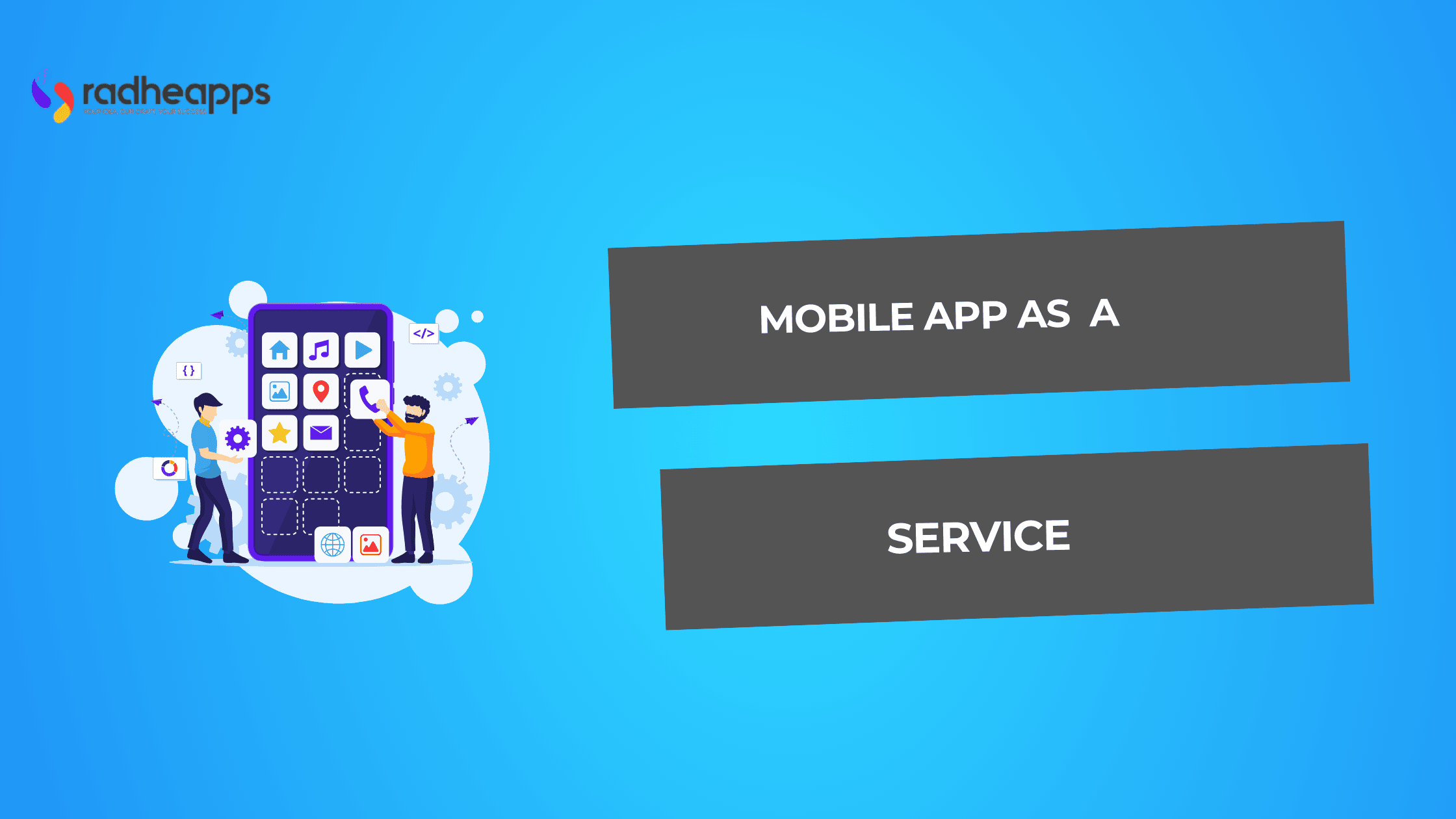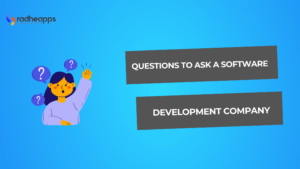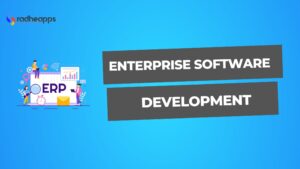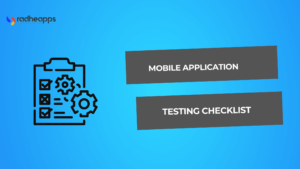Did you know that 45% of businesses do not have mobile apps? If you are one of them, you are losing one of the revenue streams. According to pwc, 60% of people prefer mobile apps to shop online. Mobile apps offer personalized recommendations, easy checkout processes, and push notifications for promotions.
All this results in higher engagement and satisfaction among consumers. If you’re a business owner experiencing a low engagement rate or looking for more revenue streams, consider launching a mobile app. But launching an app is one thing. And developing it is another.
If you’re looking for custom app development that can deliver an app that increases your revenue stream, look no further. Radheapps can help you. We have done this enough times on any platform(be it iOS, Android, or cross-platform). Our proven experience has helped businesses increase conversions by up to 94%. This would not have been possible without our team of experts at every stage.
If you have any concerns about anything, we offer a 30-minute free consultation call.
Contact us now and unplug your business app hindrance
OR
Book a call to get an app as per your enterprise needs
TL;DR- Mobile App as a Service
Here are 10 examples of MAaas you can inspiration from:
- Appy Pie
- BuildFire
- GoodBarber
- AppInstitute
- Zoho Creator
- Thunkable
- Firebase
- OutSystems
- Kony (Temenos)
- AppGyver
Why Should Businesses Consider Mobile Apps as a Service?
Businesses should because they need to engage customers, simplify operations, and increase revenue, which has led enterprises to opt for mobile apps as a service.
Here are several compelling reasons why businesses should:
1. Enhanced Customer Engagement
Direct Communication: Mobile apps provide a direct line to customers. It allows businesses to send instant updates, promotions, and announcements. All this results in fostering a sense of connection and value among users.
Personalized Experiences: Apps can tailor content and recommendations based on user preferences, improving customer satisfaction and loyalty.
2. Increased Brand Visibility
Constant Presence: An app icon on users’ devices keeps the brand visible, which then reinforces the brand recognition even the app is not actively used.
Accessibility: Mobile apps offer 24/7 access to services. It reduces customer barriers and enhances engagement opportunities.
3. Improved Customer Support
24/7 Availability: Apps can provide features such as chatbots and FAQs to ensure that the customer receives help when needed.
Streamlined Transactions: Features like one-click purchases and digital wallets make it easier for customers to buy conveniently from them.
4. Valuable Data Insights
Customer Analytics: Smartphone applications collect data on user behavior, demographics, and preferences, which allows businesses to optimize marketing programs and product offerings.
Behavioral Tracking is a way to understand users’ behavior toward the app and identify which features are successful and which need improvement.
5. Competitive Advantage
Direct Marketing Channel: Apps help businesses communicate directly with customers. This lets them bypass reliance on social media algorithms or paid ads.
Differentiation: A well-designed app can be a differentiator for a business in competitive markets, especially where the industry has been slow to adopt mobile technology.
6. New Revenue Opportunities
Monetization Opportunities: Companies can make in-app purchases, use subscription-based models, or use app advertising for further revenue sources.
Spontaneous Sales: Push messages can also facilitate spontaneous sales as they remind the users of newly launched products or limited-time deals
7. Efficiency in Operations
Internal Apps: Apps can be used for internal purposes to help make operations more efficient and productive through remote access and automating routine tasks.
Cost Savings: Businesses that automate customer interactions and support functions can reduce operational costs while enhancing service quality.
8. Scalability
Global Reach: Mobile apps enable even small businesses to connect with a worldwide audience without a physical presence.
Adaptability: As businesses grow, their apps can evolve to include new features and accommodate a larger user base seamlessly.
What is a Mobile App as a Service?
Definition and Key Features
Mobile App as a Service (MAaaS) encompasses a range of services that facilitate the entire mobile app lifecycle. It includes design, development, hosting, maintenance, and support.
Here are some key features:
Customizable Client Applications: Businesses can brand the application with their requirements, colors, and unique features.
APIs for integration: MAaaS platforms offer APIs that enable easy connections with other systems and services, which supports the functionality.
Pre-built modules: Users can choose from a library of pre-built modules to create customized solutions without extensive coding efforts.
Rapid Deployment: MAaaS greatly reduces the time to market by streamlining development processes.
Comparison Between mPaaS and Traditional App Development
| Feature | Mobile Platform as a Service (mPaaS) | Traditional App Development |
| Development Environment | It has an Integrated development environment (IDE.) | Each development process requires separate tools. |
| Customization | It offers pre-built components for quick customization | It requires extensive coding and resources |
| Time to Market | It has a faster time-to-market market. | This one is because of detailed coding and testing. |
| Maintenance | It is managed by the service provider and includes updates and support. | It requires in-house or contracted resources. |
| Cost Structure | It is typically subscription-based with lower upfront costs. | It has a higher initial investment with potential ongoing costs. |
Benefits of Mobile App as a Service
MAaaS is one way of approaching the creation and management of mobile applications for business operations. It offers several benefits. Here are nine of them:
Cost-Effective
MAaaS platforms reduce the need for substantial upfront investments in infrastructure and development. These cloud-based solutions reduce the cost of physical servers, and you only pay for what you use.
This is what makes it particularly attractive for small to medium-sized enterprises.
Faster Development and Deployment
With pre-built modules and features, MAaaS lets businesses accelerate their app development.
This ability for rapid deployment will enable companies to bring products to market quicker by responding quickly to customers’ needs and market trends.
Scalability
MAaaS solutions are scalable by their very nature. It means they enable the application to accept fluctuating loads without performance degradation.
For a business looking to grow or one whose users have periodic fluctuations, this ensures the app is functioning and responsive when it needs to be.
Easy Integrations
MAaaS provides pre-built integration with services that include payment gateways, social media, and analytics tools, which makes it easier for the app to connect with current systems and adds functionality without necessarily doing extensive development work.
Improved Experience for Users
MAaaS allows businesses to create more engaging and personalized experiences for their users by focusing on user-centric design and incorporating feedback mechanisms.
This can lead to higher customer satisfaction and loyalty.
Real-Time Data Access
Mobile apps developed through MAaaS provide businesses with real-time data access and analytics capabilities.
This empowers decision-makers with timely insights into user behavior, sales trends, and operational performance, facilitating informed decision-making.
Robust Security Features
Security. This platform usually supports various security features. It includes encryption and other security authentication systems.
Continuous Updates and Support
A firm that uses MAaaS gains ongoing updates with regard to their use of MAaaS. All maintenance is covered through the provision service provider hence does not utilize so much company in-house strength.
Businesses avoid continuous resource utilization when they use such technology.
Core Competencies
MAaaS can help businesses focus on their core activities rather than getting bogged down in the technical details of mobile app development.
This is a strategic way of outsourcing. It improves efficiency and innovation within the organization.
Core Components of Mobile App as a Service
Mobile App as a Service consists of various core components. If you are interested in using MAaaS in your business, you have to understand them. Here are nine of them:
Ready-to-Use Client Application
MAaaS platforms offer customizable client applications that businesses can configure with their branding, colors, and unique features.
This allows for quick deployment while ensuring the app aligns with the company’s identity and user expectations.
APIs for Integration
The APIs represent an essential aspect of MAaaS, which enables a smooth connection between the mobile application and other platforms or services.
Such connections allow businesses to connect their applications to systems that already exist, thus enhancing functionality and user experience.
Platform as a Service (PaaS)
MAaaS is usually based on a PaaS model, means it offers administrative tools and scripting plugins that can be used to further customize and manage the app.
This flexibility allows businesses to adapt their applications to changing needs without extensive redevelopment.
User Interface (UI) Layer
The UI layer is the user interface of the mobile application.
It is what users see and interact with, including screens, buttons, menus, and more, all of which are created to provide an engaging user experience. A good UI is very important for user satisfaction and retention.
Business Logic Layer
This layer encapsulates the core functionalities of the application, processing data and executing business rules. It handles tasks such as data calculations, order processing, and decision-making processes important to the application’s operations.
Data Layer
The data layer deals with how the application stores and retrieves information. It allows secure data transactions and ensures that all parts of the application access consistent information.
This layer is very important for data integrity and performance.
Security Features
MAaaS platforms are usually equipped with strong security measures such as encryption and secure authentication protocols to protect user data and ensure compliance with regulations.
Analytics Tools
Integrated analytics tools are used to analyse user behavior, app performance, and other metrics related to engagement for companies.
These tools help companies make better decisions regarding future updates and marketing strategies.
Maintenance and Support Services
Maintenance and support services are also typically included in MAaaS provisioning.
Both of these are to ensure that applications are always updated with the latest features and security patches without tying up significant company resources internally.
How to Implement Mobile App as a Service
The implementation of MAaas requires several strategic steps that guide businesses from initial concept to deployment and ongoing management. Here’s a structured approach to effectively implement MAaaS:
1. Define Objectives and Strategy
Identify Goals: Clearly outline what you want to achieve with the mobile app, including the target audience, key functionalities, and desired outcomes.
Market Research: Thoroughly research the market trends, competitor offerings, and user needs that would help refine your app’s value proposition and features.
2. Plan the Development Process
Choose a Development Model: It is important to decide whether to use a microservices architecture or a more conventional approach based on project requirements and the team’s capabilities.
Build a Roadmap: Establish a well-detailed project plan. It should comprise timelines, milestones, and resource allocation.
In addition, the Minimum Viable Product (MVP) must be defined in terms of launching initially.
3. Gather the Right Team
Construct a Development Team: Collect an experienced team, preferably with background experience in developing mobile applications and an understanding of the MAaaS platform.
They must understand their specific roles and responsibilities related to the project.
Choose Technology Stack: Choose suitable front-end and back-end technologies to develop your app as needed.
4. Design the User Experience
UI/UX Design: Focus on creating an intuitive user interface and seamless user experience. Develop wireframes, mockups, and prototypes to visualize the design of your app.
Feedback Loop: Engage your potential users during the design process to gather their feedback and necessary adjustments before proceeding with development.
5. Developing the Application
Use MAaaS Features: Leverage pre-built components and APIs offered by MAaaS platforms to speed up development.
Implement Core Functionalities: Implement the main features of the app based on the roadmap while maintaining scalability and integration capabilities.
6. Testing and Quality Assurance
Conduct Thorough Testing: Engage QA specialists to test functionality, performance, security, and usability across various devices and operating systems.
Iterate Based on Feedback: Use testing insights to further evolve the app before launching it to end-users.
7. Deployment
Launch the App: Publish your mobile application across platforms through the Apple App Store or Google Play Store.
Marketing Strategy: Use marketing campaigns to publicize your application and push its adoption after launching it.
8. Post-Launch Support and Maintenance
Ongoing Maintenance: Evolve the app by regularly adding features and new upgrades and rectifying bugs based on user reviews and feedback.
Monitor Performance: Use the analytics to track user engagement, retention rates, and other KPIs that will guide future updates.
Examples of Mobile App as a Service Applications
Here are 10 examples of MAaas you can take inspiration from:
Appy Pie
Appy Pie is a no-code development platform for mobile apps that can design applications without programming experience.
It allows businesses to create mobile apps for e-commerce, education, or entertainment.
BuildFire
BuildFire is a powerful app development platform that allows users to create custom mobile apps.
Its features include push notifications, social media integration, and analytics.
GoodBarber
GoodBarber is one of the leading mobile application design platforms. Its emphasis is on making your app look visually appealing.
This platform lets users build native apps for iOS and Android that provide push notifications, user management, and monetization.
AppInstitute
AppInstitute is exclusively designed for small businesses to quickly create their mobile apps.
This tool features an easy drag-and-drop interface to make app-building easier.
Zoho Creator
Zoho Creator is a low-code application development platform to make custom mobile apps that can meet their particular needs.
It’s robust data management capabilities and integrations with other Zoho products makes it suitable for organizations looking to streamline operations and increase efficiency.
Thunkable
Thunkable is a no-code platform. Using a visual interface, users can design and build mobile applications.
Thunkable allows for the development of iOS and Android applications and has the potential to create cross-platform apps.
Firebase
Firebase, by Google, is an all-in-one set of tools for mobile app development, including real-time databases, authentication services, and cloud storage.
Although it does need some coding, Firebase has really good documentation and community support for developers who wish to create scalable applications.
OutSystems
OutSystems is an enterprise-grade low-code platform. Organizations may use this to develop applications in complex mobile platforms quickly.
Kony (Temenos)
Kony is a cloud-based mobile development platform for enterprises.
It specializes in high-performance apps. It also supports offline access and multi-channel capability.
AppGyver
AppGyver is one platform that does not require users to code and allows them to create fully functioning mobile applications.
As such, they offer an easy drag-and-drop interface, along with various prebuilt components and integrations, which makes this platform ideal for entrepreneurs or small businesses to launch their apps quickly.
Mobile Apps as Service Providers: How to find the best platform
It is very essential to find the best MAaas provider. This is to develop and manage mobile applications efficiently. Here are some key considerations and steps to help you identify the right platform:
1. Features and Functionality
Core Services: Seek out services that provide basic services such as user authentication, cloud storage, analytics, push notifications, and database management.
Platforms like Google Firebase and AWS Amplify are popular for their wide range of features that cater to various app needs.
Customization Options: Ensure the platform provides ease of customization of applications to suit specific business needs.
2. Scalability
Select a platform that can scale up with your business. Scalability is important as it will take care of additional user loads and scalability in functionalities as time progresses.
AWS Amplify is known to be scalable strongly because of Amazon’s vast infrastructure.
3. Ease of Use
Easy usability can considerably reduce the time taken to develop an application.
Platforms such as Back4App provide drag and drop interfaces where applications can easily be created by even those having limited coding expertise.
4. Integration Capabilities
Integration with existing tools and services is very important.
Choose platforms that offer APIs for seamless integration with third-party services, such as payment gateways and social media platforms.
5. Support and Documentation
Comprehensive support and detailed documentation are important for troubleshooting and to get the most out of the platform.
Ensure that the provider offers responsive customer support and extensive resources.
6. Cost Structure
Compare the pricing models of each site. Some might charge according to usage, and others have flat monthly fees. Be sure to find one that falls within your budget and projected use.
7. Security Features
The platform should also have strong security features, which include data encryption, secure authentication protocols, and compliance with data protection regulations.
Challenges and Solutions in Mobile App as a Service
MAaas has its own set of hurdles. It is essential to find obstacles and available resolutions to deal with them if you want to successfully implement a mobile application to leverage their functionalities effectively.
Here is an overview of key challenges and some available resolutions that have been outlined for the Mobile App as a Service:
Data Management
Challenge: The large amount of data management is challenging, Especially for data-intensive organizations such as retail and healthcare.
To ensure data accessibility, synchronization, and consistency across devices can be complex due to intermittent connectivity and varying network conditions.
Solution: The database can be a cloud-based system, and real-time synchronization and offline access are necessary.
It is ensured that data access does not get affected in case connectivity is lost. Good caching strategies are also employed for the proper management of data.
Performance and Scalability
Challenge: As user demand grows, maintaining app performance and scalability becomes critical.
Poor resource management can lead to server overloads and inefficient database queries, which negatively impact user experience.
Solution: Use Agile practices and DevOps practices to make performance management scalable.
Thorough testing and iteration will enable early detection of bottlenecks that do not yet affect users.
Cross-Platform Compatibility
Challenge: Due to the availability of apps on numerous devices and OSs, maintaining a uniform experience on all of them is not feasible. Developers must handle device fragmentation and screen sizes to offer an uninterrupted experience.
Solution: Use React Native or Flutter. They are platform-agnostic and do not cause a hassle with different codebases, which might have occurred without this, to maintain a uniform user experience.
Security Issues
Challenge: Security breaches and unauthorized access are the vulnerabilities of mobile apps. Business enterprises are concerned with the security of sensitive user data and also must adhere to regulation.
Solution: Include the feature of end-to-end encryption along with multi-factor authentication, conduct regular security audits, and guard user data based on applicable regulations.
User Interaction and Retention
Challenge: High competition in the app market makes it hard to gain and sustain users.
Many apps drop off in high numbers right after their installation, which points to the fact that a user engagement strategy must be strong.
Solution: Investment in UI/UX design so that it brings intuitive interfaces.
The integration of a feedback mechanism will be really helpful to the app by shaping it according to its user’s preferences. As a result, retention will grow.
Interface with Existing Systems
Challenge: The integration of mobile applications with enterprise systems often proves challenging. It involves careful planning and execution for adequate data flow and functionality.
Solution: During the development phase, integration planning should be given priority by choosing MAaaS platforms that provide APIs.
MAas allows easy connectivity with existing systems for a seamless transition between mobile apps and enterprise solutions.
Development Costs and Resource Allocation
Challenge: High-quality applications cannot be developed often because of budget constraints.
Enough resources are needed for the development, testing, and marketing phases, which are usually unaffordable for most organizations.
Solution: Market research should be conducted before development to understand potential ROI. It allows for better budget allocation for features that drive user engagement and retention.
Frequently Asked Questions (FAQs)
How does a Mobile App as a Service Simplify App Development?
Mobile App as a Service (MAaaS) simplifies app development by providing pre-built modules and backend services. It allows developers to focus on the frontend user experience.
Are Mobile Apps Suitable for Startups As A Service?
Yes, mobile apps are highly suitable as a service for startups. They are cost-effective, have a faster time to market, require lower operational complexities, and are very flexible.
How Secure are mPaaS Platforms?
MPaas are generally secure because they have robust security measures such as data encryption, secure authentication protocols, and compliance with industry standards.
Can I Integrate Custom Features into a Mobile App As A Service Solution?
Yes, you can. These platforms typically enable developers to add unique functionalities tailored to their specific business needs.
What is the Cost Structure for a Mobile App As A Service?
The cost structure for MAaaS can vary widely depending on the provider and the services included. However, most of them are either subscribtion-based or usage-based pricing.
Conclusion
Ultimately, MAaas is a transformational opportunity for businesses looking to improve customer engagement, streamline business operations, and drive sales. It offers cost efficiency, scalability, and accessibility to advanced technology without drawing upon expensive in-house resources.
However, to fully take advantage of these benefits, Choosing the right mobile app development partner is essential. Factors such as expertise, communication practices, and post-launch support must be considered to avoid common pitfalls and ensure a successful app development journey. Overall, a mobile app would greatly enhance the market presence of your business and foster long-term growth.
By the way, If you are looking to increase your market presence with a mobile app, Radheapps can assist you. We not only develop apps but also do it cost-effectively. Our experience in IOS, Android, and cross-platform apps empowers our clients with knowledge beyond one platform. Most businesses are sick of apps offering generic features that fail to address unique requirements, we focus on delivering greater ROI by giving features that are designed to meet your exact needs.
So, if you are looking for a scalable app to support your rapid growth, an app that can integrate with your legacy system, and an app that suits your unique business needs, book a FREE strategy call today.
Get in touch to start building your online business presence.




